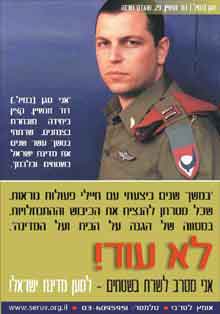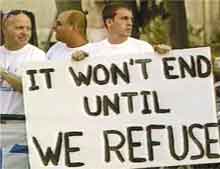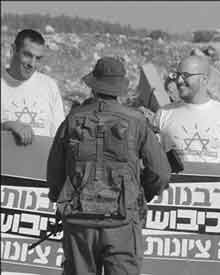General, your tank is a powerful vehicle
It tramples the forest, it crushes a hundred men.
But it has one flaw:
It requires a driver.
General, your bomber is strong.
It flies faster than the storm, it loads more than an elephant.
But it has one flaw:
It requires a mechanic.
General, man is very useful.
He knows how to fly, he knows how to murder.
But he has one flaw:
He knows how to think.
–Bertolt Brecht, a German anti-Nazi playwright and poet.
The poem was used in a Yesh Gvul flyer.
In June 1967, the Six-Days War ended in Israel’s triumph over its neighboring Arab states. No matter how one perceives this war, whether as a war of self-defense or a war of aggression, annexing the territories and establishing settlements was a clear choice Israel made. The seizure and administration of these Palestinian territories has required a harsh military occupation, which includes different practices that many soldiers find immoral and unjust. The second Al-Aqsa Intifada, and the Israeli response to it under Ariel Sharon’s government brought about the cruelest and most oppressive regime Palestinians have ever faced; killings, targeted assassinations, curfews, house demolition, tree uprooting, the segregation wall, and other human rights violations have created a new wave of refusniks (conscientious objectors) Israel has never faced before.
Coalition of Conscientious Objectors
Starting in 2001, Shministim (high school seniors) Israeli Youth Refusal Movement, Courage to Refuse, Refusers Parents’ Forum, and Refusers Solidarity Network launched a remarkable conscientious objectors movement in Israel. The Shministim organization was established in 2001 by a group of high school seniors who were supposed to be drafted into the army at the end of that year. These students looked for new ways to express their opposition to the Israeli occupation. They decided to adopt a radical approach never used before by a group of high school seniors, and wrote an open letter to Sharon expressing their reasons for refusing to serve in the military in August 19, 2001. The letter opens, “We … are about to be called to serve in the IDF [Israeli Defense Force]. We protest before you against the aggressive and racist policy pursued by the Israeli government’s [sic] and its army, and to inform you that we do not intend to take part in the execution of this policy… Therefore we will obey our conscience and refuse to take part in acts of oppression against the Palestinian people.” The Shministim Letter immediately received full coverage in all of the Israeli media, and in a number of Palestinian, American, and European newspapers and TV shows. One of the harshest responses came from the then Minister of Education, Limor Livnat from the Likud Party, who said that these students were an insignificant minority that did not distinguish “between an aggressor and victim.” Left wing politicians rejected the refusal letter as well, under the claim that it threatened to break down the fundamental fabric of Israeli society. Nevertheless, numerous responses of support arrived from Palestinians, Israelis or foreigners who thought that conscientious objection has been a legitimate way to promote peace. Although the letter’s first endorser was imprisoned for refusing the draft in January 2002, this did not weaken the movement but made it stronger. The Shministim movement created a new wave of refusnik students, and today this group works on mobilizing more conscientious objectors through raising domestic and international awareness to the Israeli occupation.
Combined with Shministim, the foundation of Courage to Refuse established the Refusnik Movement as a force of significant opposition to government policies in the territories. On January 25, 2002, a group of 52 officers and soldiers published the Combatants Letter, which expressed their reasons for refusing to serve in the occupied territories. Captain David Zonshein and Lieutenant Yaniv Itzkovits, the initiators of the letter, were then officers in an elite unit which took part in fighting in Lebanon and in the occupied territories. They also had served for four years in compulsory service and eight years in the reserves. During service in the Palestinian territories, Zonshein and Itzkovits came to believe that Israel was violating the Oslo Accords by expanding settlements and maintaining an immoral and unjust occupation of the Palestinian people. Facing this reality, Zonshein and Itzkovits decided that they could not continue their service in the occupied territories. Therefore, they initiated the refusal letter and established Courage to Refuse, which as of March 2005 included 635 refusniks. In Breaking Ranks, Ronit Chacham writes, “Courage to Refuse movement…[hoped] that their letter would act as a wake-up call…[T]hey now felt a strong need to persuade their fellow Israelis that the ongoing occupation did not serve a defensive purpose and was depriving Palestinians of their rights. They challenged the belief, widely held in Israel, that their country had to protect itself in this way against Palestinian determination.” Additionally, Courage to Refuse promotes new refusals, supports jailed members and their families, and holds demonstrations against the Israeli government. Furthermore, refusniks speak in high schools, universities and other forums to promote an end to the occupation, in addition to meeting parliament members and U.S. congressmen. In an important milestone for the movement, refusniks and parents of jailed refusniks appeared at the European Parliament in Strasbourg, France, on March 10, 2004, where they spoke about their own experiences and their views on the military’s role in the occupation.
Courage to Refuse has been more successful than Shministim primarily because for many Israelis it was easier to accept and support former soldiers, who had already served in the army, as conscientious objectors than high school seniors who had not completed their duty to the state. Although ex-soldiers refusniks have already committed the atrocities that they have been trying to stop, whereas the students have been trying to avoid committing them at all, the part of the Israeli public which supports refusal views the ex-soldiers in a more positive light. Another factor that contributes to the success of Courage to Refuse is that its members cannot be dismissed as being radical leftists because many of them are not a part of the radical left. For these reasons, Courage to Refuse has been able to change how the Israeli public perceives the military occupation and open up a debate about its necessity, legality, and morality.
The Second Phase
The second phase of the Refusnik Movement was launched by the Pilots Letter on September 27, 2003. In this letter, Israeli air force pilots wrote, “We…are opposed to carrying out attack orders that are illegal and immoral of the type the state of Israel has been conducting in the territories…We… refuse to take part in Air Force attacks on civilian population centers…These actions are illegal and immoral, and are a direct result of the ongoing occupation which is corrupting all of Israeli society.” Yonatan Shapira, one of the letter’s initiators, explained that the Shehade incidence, wherein an air-strike targeted assassination killed the target in addition to 14 civilians, nine of them children, raised many concerns for himself and his group. Additionally, the Commander of the Air Force, Dan Halotz, was quoted as saying that it does not bother him that civilians were killed in the attack and that it should not bother his men. This statement led Shapira and his co-signers to refuse carrying out immoral orders such as this one, because they felt the army lost its moral grounds when soldiers and officers stopped caring for civilians’ lives. The Pilots Letter shocked Israeli society because it came from the most respected and adored group in the army in particular and in Israeli society in general. The pilots were highly criticized by many Israelis and were released from service the following month. Nevertheless, the Pilots Letter helped promote conscientious objection as a legitimate tool for opposing the military occupation, and altered Israelis perception on its moral applications. In response to the Pilots Letter, Gila Svirsky expressed her hope for peace: “This letter is a blessing. May it catalyze a speedy end to the occupation, and presage the dawn of reason and, ultimately, peace—in the Middle East and everywhere.”
The last noteworthy milestone in the Refusnik Movement came from Sayeret Matkal, the Israeli Defense Force General Staff’s Elite Special Operations Force, which is well known for its famous members Ehud Barak and Benjamin Netanyaho. On December 21, 2003, 13 Sayeret Matkal soldiers and officers signed a refusal letter stating, “We…have also chosen to join the front in the way we have been trained…We say to you today, we will no longer lend our hands to the subjugation taking place in the territories.” In this letter the undersigned expressed their solidarity with the Refusnik Movement and why they felt obligated to join it. Since the submission of the Combatants, Pilots and Sayeret Matkal’s refusal letters, new refusniks, from almost every army unit, have either written their own refusal declarations or joined these existing groups. These hundreds of new refusniks strengthen the movement tremendously. Arik Diamant describes the influence of the Refusnik Movement and how the movement’s message has resonated and influenced the political arena: “For the love of their country and respect for the most fundamental Jewish values, hundreds of soldiers refused to cross the 1967 borders and were consequently sent to prison. But their message went through, and today, three years later, Sharon recognizes the refusal movement as one of the reasons for leaving Gaza.” Additionally, Michal Levertov writes,
At the end of 2003, many political analysts were crediting the refusniks’ campaign with the revival of the Israel left…The Refusniks ‘moved from Israeli society’s margin to its center’ the daily Maariv wrote. In 2002, David Zonshine, a captain in the paratroops, was nominated as ‘person of the year’ by the daily Yediot Ahronot. He didn’t win the title then, but in moving from the fringes to the forefront of Israeli political and public discussion, Courage to Refuse won big in 2003 as a generator of a new, saner, spirit.
Furthermore, Zonshine and the organization he established, Courage to Refuse, formed one of the category nominees for the 2004 Nobel Peace Prize. Although Zonshine did not win the Nobel Peace Prize, these recent developments point out the tremendous success that the Refusnik Movement has had in shifting public opinion against the military occupation and its methods.
Into a Peace Army
While the Refusnik Movement is a remarkable landmark in the Israeli peace movement, it does not provide an alternative to the Israeli Defense Force as an institution that addresses conflicts. Hence, the next section will present an alternative to the Israeli army in the form of a peace force. Additionally, I will detail the new organization’s core principles and stages of development. Itamar Shahar wrote in his refusal declaration the following statement: “Initially, I thought it might be possible to try and improve these circumstances to a degree, but ultimately I understood that the only way for an ordinary soldier to defend the wellbeing of all concerned, Palestinians and Israelis, is by refusing to take a hand in the occupation apparatus.” As Shahar claims, changing the army’s social practices is impossible because violence is rooted in the army’s structure and system of meaning. Hence, there is an urgent need to establish an alternative organization to replace the military system all together.
This substitute organization would be a nonviolent peace force which would serve as a Civilian-Based Defense institution for the benefit of all the people in the region. The aims of the peace force would be threefold, similar to the aims of the Gandhian Shanti Sena (Peace Army). (A peace army was established by Badshah Khan and the Pathans in the North-West Frontier Province and it opposed the British colonial occupation of India. This army included 80,000 soldiers and was called the Khudai Khidmatgars, described on page 18 of this issue and in the book Nonviolent Soldier of Islam by Eknath Easwaran. )
The first goal of the peace force would be to prevent any outbreak of violence in the region. Secondly, if violence did break out, the peace force would use nonviolent methods to bring the situation under control in order to start a process of conflict transformation and find a peaceful solution to the disagreement. The third goal would be to create a situation in Israel and Palestine in which war and violent conflicts would be outlawed.
In this context, the growing number of refusniks, who currently withhold their support and cooperation from the army, would eventually lead to the collapse of the military establishment. Until the collapse of the military establishment, the refusniks should aim to institute the alternative organization with themselves as the core group of members. Additionally, the peace force lines would be open to any volunteer, man or woman, Israeli or Palestinian. The organization’s mission statement would include resolving conflicts nonviolently, promoting peaceful solutions to disputes, acting to guarantee common security for all human beings, and intervening in the midst of violence as a nonviolent third party (Nonviolent Third Party Intervention is used today by the Peace Force, and Peace Brigades International). The peace force members must believe, accept and be trained in the discipline of nonviolence in order to present an alternative model of conflict resolution to the violent approach of the military. In addition, the members would have distinctive and recognizable uniforms, so that in a time of conflict the peace force would be able to act freely without being hurt by either side of the disagreement. The peace force should also establish local cells, which would operate in every community and assist them in acquiring the ability and techniques to solve problems on their own. The local cells could also work as mediators in disputes, educators for peace, or organizers of peace rallies. By adopting these roles as the organization’s social practices, the peace force would also serve as a peace keeping and peace building institute in Israel and Palestine. This peace force model, which provides peace making, keeping, and building services, can be and should be implemented in other areas of conflict around the world. Doing so would allow different communities to resolve their conflicts in a nonviolent and peaceful manner.




